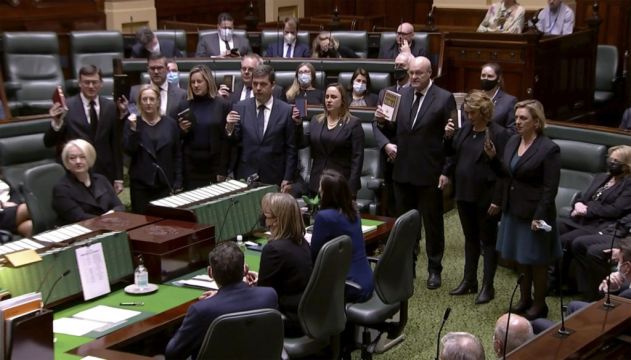MPs in an Australian state have pledged their allegiance to Britain's King Charles III, with some using the occasion to call for a republic.
Australia’s centre-left Labour Party government wants an Australian president to replace the British monarch as the nation’s head of state.
The death of the queen last week after a 70-year reign is seen by many as an ideal opportunity for change.
Lawmakers from the minor Greens party used their swearing-in ceremony in the Victoria parliament to advocate for an Australian head of state.
“We’re here as Victorian MPs to swear allegiance to King Charles III, a new head of state decided for us, but not by us,” Greens leader Samantha Ratnam told reporters before the ceremony, referring to members of Parliament.
“This is a really important time to reflect on the role of the British monarchy going forward in Australia, the impact of colonisation and the need to move forward in this country with a treaty and with a republic,” Ms Ratnam added.
Despite the protest, all four Greens lawmakers fell in with the rest in swearing or affirming their allegiance to the king, whose is head of state of Britain, Australia and another 13 countries that were once part of the British Empire.
Three Greens lawmakers wore clothes with slogans that highlighted that the British colonised Australia without signing a treaty with its Indigenous people.
The ceremony in Australia’s second-most populous state, which is named after the 19th century monarch Queen Victoria, was the result of a legal quirk that underscores how complicated the process of Australia severing its constitutional ties with Britain’s monarch could become.
Lawmakers’ pledge of allegiance in the other five states and in the Australian parliament roll over from the late queen to her eldest son.
Victoria demands a new oath to a dead monarch’s successor before lawmakers can vote on motions or legislation — a procedure one expert called a “silly quirk”.
“They’ve got a clause in their constitution that shouldn’t be there,” George Williams, a University of New South Wales constitutional lawyer, said.
“Really, you don’t need it. You should have the oath … to the monarch’s heirs and successors” as occurs in the Australian Parliament, Mr Williams said.
Australians voted in a 1999 referendum against Australia becoming a republic and breaking its constitutional ties to its former colonial master.
If that referendum had succeeded in establishing an Australian president, the states were expected to eventually take the same step, Mr Williams said.
Mr Williams did not consider an Australian republic with state monarchies would be sustainable in the long term.
“It would be symbolically fraught and pretty inconvenient and wouldn’t make much sense either to be a republican nation and have state monarchies,” Mr Williams said.
“I don’t think anyone would think it would last very long, but it’s at least a theoretical possibility,” Mr Williams added.
Adelaide University Law Professor Greg Taylor said the potential for states to resist ending their links to monarch was no reason for Australia not to hold a second referendum on becoming a republic.
“There are very good reasons for not doing it, but ‘it’s too hard’ is not one of them,” Prof Taylor said.
He said the German Empire from 1871 until 1918 was an example of a coalition of monarchies and republics.
“So such a thing is possible. I think personally it would be rather odd,” Prof Taylor, said referring to the possibility of state monarchies remaining in an Australian republic.
The British monarch is represented across the Australian nation by a governor-general who is appointed by the monarch on the advice of the prime minister.
The monarch is represented in each state by a state governor appointed on the advice of the state premier.
The Australian Capital Territory and Northern Territory do not have the same rights as states and their links to the monarch are less direct.







